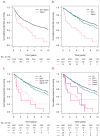Signet Ring Cell Colorectal and Appendiceal Cancer: A Small Signet Ring Cell Component Is Also Associated with Poor Outcome
- PMID: 37173961
- PMCID: PMC10177230
- DOI: 10.3390/cancers15092497
Signet Ring Cell Colorectal and Appendiceal Cancer: A Small Signet Ring Cell Component Is Also Associated with Poor Outcome
Abstract
Background: Colorectal signet ring cell (SRC) carcinoma with ≥50% SRCs (SRC ≥ 50) has a poor prognosis, but the prognostic role of SRCs < 50% (SRC < 50) is unclear. The aim of this study was to provide a clinicopathological characterization of SRC colorectal and appendiceal tumours and analyse the importance of the SRC component size.
Methods: All patients in the Swedish Colorectal Cancer Registry diagnosed with colorectal or appendiceal cancer in 2009-2020 at Uppsala University Hospital, Sweden, were included. The SRCs were verified, and the components estimated by a gastrointestinal pathologist.
Results: Of the 2229 colorectal cancers, 51 (2.3%) had SRCs, with a median component size of 30% (interquartile range of 12.5-40) and 10 (0.45%) had SRC ≥ 50. The SRC tumours were primarily localized in the right colon (59%) and appendix (16%). No patients with SRCs had stage I disease, and 26 (51%) had stage IV, of whom, 18 (69%) had peritoneal metastases. The SRC tumours were often high grade with perineural and vascular invasion. The 5-year overall survival (OS) rate for patients with SRC ≥ 50 were 20% (95% confidence interval (CI) 6-70), for SRC < 50, 39% (95% CI 24-61); and for non-SRCs, 55% (95% CI 55-60). Among the patients with SRC < 50 and <50% extracellular mucin, the 5-year OS was 34% (95% CI 19-61), while those with ≥50% extracellular mucin had an OS of 50% (95% CI 25-99). The 5-year recurrence-free survival rates were 51% (95% CI 13-83) for patients with SRC tumours, as compared to 83% (95% CI 77-89) and 81% (95% CI 79-84) for mucinous and non-mucinous adenocarcinoma, respectively.
Conclusions: The presence of SRCs was strongly associated with aggressive clinicopathological features, peritoneal metastases, and poor prognosis, also when they make up <50% of a tumour.
Keywords: appendiceal cancer; colorectal cancer; peritoneal metastases; signet ring cells.
Conflict of interest statement
The authors declare no conflict of interest.
Figures





References
-
- Nagtegaal I.D., Odze R.D., Klimstra D., Paradis V., Rugge M., Schirmacher P., Washington K.M., Carneiro F., Cree I.A., WHO Classification of Tumours Editorial Board The 2019 WHO classification of tumours of the digestive system. Histopathology. 2020;76:182–188. doi: 10.1111/his.13975. - DOI - PMC - PubMed
-
- Hyngstrom J.R., Hu C.-Y., Xing Y., You Y.N., Feig B.W., Skibber J.M., Rodriguez-Bigas M.A., Cormier J.N., Chang G.J. Clinicopathology and outcomes for mucinous and signet ring colorectal adenocarcinoma: Analysis from the National Cancer Data Base. Ann. Surg. Oncol. 2012;19:2814–2821. doi: 10.1245/s10434-012-2321-7. - DOI - PMC - PubMed
-
- Barresi V., Reggiani Bonetti L., Ieni A., Caruso R.A., Tuccari G. Histological grading in colorectal cancer: New insights and perspectives. Histol. Histopathol. 2015;30:1059–1067. - PubMed
Grants and funding
LinkOut - more resources
Full Text Sources
Miscellaneous

